-

新人教版高中英语必修2Unit 1 Cultural Heritage-Discovering Useful Structure教案二
This theme of the part is “ Describe people or things in greater detail”. Students have learned the grammar(restrictive relative clauses) in Book 1, and further review and consolidate its structure “prep+relative pronouns(which/whom)” and the relative adverbs(when, where and why), besides students should understand its form, meaning and functions. In this section, students should be able to express the grammar correctly in daily communication and in the writing. 1. Review the basic usages of relative pronouns and adverbs of attributive clauses . 2. Learn to use some special cases about restrictive relative clauses.3. Learn to write sentences with restrictive relative clauses flexibly according to the context.1. Review the basic usages of relative pronouns and adverbs of attributive clauses .2. Learn to use some special cases about restrictive relative clauses.3. Learn tow rite sentences with restrictive relative clauses flexibly according to the context.Step 1. Observe the following sentences, and mark the relative pronouns and the adverbs. 1. After listening to the scientists who had studied the problems, and citizens who lived near the dam, the government turned to the United Nations for help.2. Temples and other cultural sites were taken down piece by piece, and then moved and put back together again in a place where they were safe from the water.Step 2 PracticePlease complete these sentences with relative pronouns and relative adverbs and answer the following questions.Questions: 1. What is the head noun ?2. What relative words should be used ?3. What elements do they act in these sentences ?

新人教版高中英语必修2Unit 1 Cultural Heritage-Reading For Writing教案
This report is short, concise and has typical news content and language features. The title uses the verb phrases, embodying the characteristics of being concise and general. The introduction is the first two sentences in the first paragraph, describing the general situation of the cultural heritage protection project, including time, place, characters, events and other news elements, so that readers can see the main points of the news report at a glance. The main body is the second and third paragraphs, which report the important historical and cultural value of Mogao Grottoes and the production of Mogao Grottoes Material digital photos, which are of great significance to the inheritance of historical culture and the promotion of international cultural understanding, exchange and cooperation. Direct citation is used in the report, as well as background introduction and other news writing techniques.1. Get students to have a good understanding of some features about a news report by reading the text.2. Instruct students to write a summary about a news report properly using some newly acquired writing skills in this period.3. Develop students’ writing and cooperating abilities.4. Strengthen students’ great interest in writing discourses.1. Stimulate students to have a good understanding of how to a summary about a news report 2. Cultivate students to write a news report properly and concisely.Step 1: Lead in Do you think it is necessary for us to circulate our cultural heritage to the world? Why or why not?Do we need to learn more about other countries’ cultural heritage? Why or why not?Step 2: Read to discover details concerning the main body of the news report.

新人教版高中英语必修2Unit 3 The Internet-Discovering Useful Structure教案二
This teaching period mainly deals with grammar “The Present Perfect Passive Voice.” To begin with, teachers should lead students to revise what they have learned about the Present Perfect Passive Voice. And then, teachers move on to stress more special cases concerning this grammar。This period carries considerable significance to the cultivation of students’ writing competence and lays a solid foundation for the basic appreciation of language beauty. The teacher is expected to enable students to master this period thoroughly and consolidate the knowledge by doing some exercises. 1. Guide students to review the basic usages of the Present Perfect Passive Voice2. Lead students to learn to use some special cases concerning the Present Perfect Passive Voice flexibly.2. Enable students to use the basic phrases structures flexibly.3. Strengthen students’ great interest in grammar learning.1. Help students to appreciate the function of the Present Perfect Passive Voice in a sentence2. Instruct students to write essays using the proper the Present Perfect Passive Voice.观察下列句子特点,总结共同点。1.(教材P28)Much has been written about the wonders of the World Wide Web.2.(教材P28)But the Internet has done much more for people than simply make life more convenient.3.(教材P28)Many people have been helped by the club.4.(教材P28)She no longer feels lonely, and her company has become quite successful.5.(教材P32)Today I thought I’d blog about a question that has been asked many times—how do you stay safe online and avoid bad experiences on the Internet?

新人教版高中英语必修2Unit 4 History and Traditions-Listening&Speaking&Talking教案一
This unit is about history and traditions. From the opening page, we can know that this unit will introduce the history and traditions around the world. As Marcus Garvey says “A people without the knowledge of their past history, origin and culture is like a tree without roots”, it is important for students to realize the importance and value of knowing the history and traditions and their further meanings. And this part ( listening and speaking ) is divided into two parts: Part A---share views on historic sites, Part B ---talk about a visit to a historic tourist destination. By talking with a foreigner, the speakers introduce the historic attractions and their cultures. Part A is that William, a British student, who was going to visit the Confucius Temple and a Chinese student, Xiao Kong, who was going to the Confucius Temple to meet with the members of the research group, went together and exchanged their views on the Confucius Temple, Confucius, Confucius' descendants and Confucius' educational thoughts. Part B is a conversation between Xiao Yan, a youth hostel receptionist and Paul, a backpacker about the feelings and experience after visiting the Chinese famous tourist attraction Pingyao.1. Guide students to understand the content of listening texts in terms of the whole and key details; 2. Cultivate students' ability to guess the meaning of words in listening; discuss with their peers how to talk about historic spots and great person.3. Instruct students to use functional sentences of showing one’s excitement, surprise and disappointment.1. Guide students to understand the content of listening texts in terms of the whole and key details; 2. Cultivate students' ability to discuss with their peers the related topics.3. Enable students to use the functional items of showing one’s excitement, surprise and disappointment.

新人教版高中英语必修2Unit 4 History and Traditions-Reading for Writing教案
Step 1 Lead inThere are many interest of places in the UK. What do you know ?The Big Ben the London Tower the Thames RiverStep 2 Before reading---analyze the titleBeautiful Ireland and its traditionWe know that the article mainly tells about the beauty and traditions of Ireland. Step 3 While reading---Task 1Read the text and answer the following questions.Q1: What makes the Irish countryside exciting and inspiring?Its beauty and how it offers something for all the scenes.Q2: What are the best ways to experience some Irish traditions and cultures?By stopping by a village pub and relaxing with a drink and traditional meal while listening to music and watching dancingQ3: What is the meaning of “breathe in the sweet scent of fresh flowers while birds greet the new day with their morning song ?”It means to not just smell but also breathe in the smell of fresh flowers early in the morning as the birds sing their first song of the new day.Q4: What are the best ways to experience Chinese traditions and customs ?By travelling to different places and using all your senses to experience everything and by interacting with local people.Step 4 While reading---Task 2Analyze the descriptive paragraph1. Identify and underline the paragraph’s introductory sentence and the ending sentence.Introductory sentence: Ireland’s beautiful countryside has always had a great influence on its people and traditions.Ending sentence: And if you introduce yourself to a friendly face, you are more than likely to experience local culture and customs first-hand.2. The paragraph talks about different senses in different places. Write the senses and places in the order that they appear.
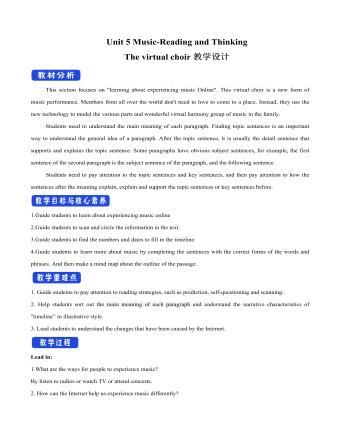
新人教版高中英语必修2Unit 5 Music-Reading and Thinking教案一
This section focuses on "learning about experiencing music Online". This virtual choir is a new form of music performance. Members from all over the world don't need to love to come to a place. Instead, they use the new technology to model the various parts and wonderful virtual harmony group of music in the family. Students need to understand the main meaning of each paragraph. Finding topic sentences is an important way to understand the general idea of a paragraph. After the topic sentence, it is usually the detail sentence that supports and explains the topic sentence. Some paragraphs have obvious subject sentences, for example, the first sentence of the second paragraph is the subject sentence of the paragraph, and the following sentenceStudents need to pay attention to the topic sentences and key sentences, and then pay attention to how the sentences after the meaning explain, explain and support the topic sentences or key sentences before.1.Guide students to learn about experiencing music online2.Guide students to scan and circle the information in the text.3.Guide students to find the numbers and dates to fill in the timeline.4.Guide students to learn more about music by completing the sentences with the correct forms of the words and phrases. And then make a mind map about the outline of the passage.1. Guide students to pay attention to reading strategies, such as prediction, self-questioning and scanning.2. Help students sort out the main meaning of each paragraph and understand the narrative characteristics of "timeline” in illustrative style.3. Lead students to understand the changes that have been caused by the Internet.
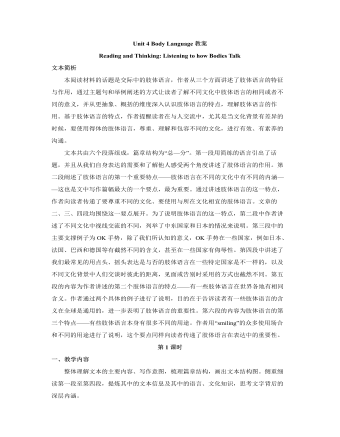
新人教版高中英语选修1Unit 4 Body Language教案
本阅读材料的话题是交际中的肢体语言,作者从三个方面讲述了肢体语言的特征与作用,通过主题句和举例阐述的方式让读者了解不同文化中肢体语言的相同或者不同的意义,并从更抽象、概括的维度深入认识肢体语言的特点,理解肢体语言的作用。基于肢体语言的特点,作者提醒读者在与人交流中,尤其是当文化背景有差异的时候,要使用得体的肢体语言,尊重、理解和包容不同的文化,进行有效、有素养的沟通。文本共由六个段落组成,篇章结构为“总—分”。第一段用简练的语言引出了话题,并且从我们自身表达的需要和了解他人感受两个角度讲述了肢体语言的作用。第二段阐述了肢体语言的第一个重要特点——肢体语言在不同的文化中有不同的内涵——这也是文中写作篇幅最大的一个要点,最为重要。通过讲述肢体语言的这一特点,作者向读者传递了要尊重不同的文化、要使用与所在文化相宜的肢体语言。
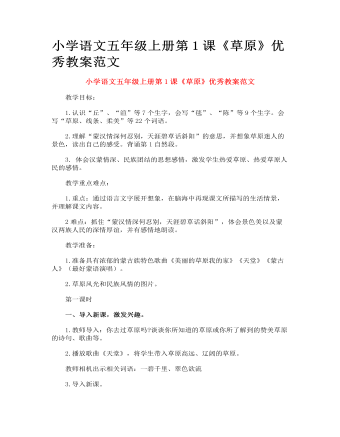
小学语文五年级上册第1课《草原》优秀教案范文
初读课文,学习字词。 1.提出读书要求:默读课文,一边读一边画出不认识的字和不理解的词,并借助词典等学习工具书理解。 2.教师检查学生学习情况。 (1)检查生字读音。 小丘( qiū)渲染(xuàn )迂回( yū)蒙古包( měng ) 襟飘带舞( jīn )鄂温克(è) (2)指导易混淆的字。 “襟”是左右结构,左边是“衤”,与衣服有关,表示衣服胸前的部分。 “涩”是左右结构,右边下面是“止”,不能写成“上”。 “裳”下面是“衣”,与衣服有关。 “微”:中间部分不能少一横。 (3)理解较难的词语。 ①联系上下文理解词语。 草原上行车十分洒脱,只要方向不错,怎么走都可以。 “洒脱”的意思是:潇洒自然,不拘束。这个词语反映了草原的广阔无边。 ②理解“襟飘带舞”一词的意思,可以出示蒙古族鲜艳的服装来分析,意思是:衣襟和裙带随风舞动。 ③“翠色欲流”一词可以从难字入手理解,比如“欲”在这里表示“将要”的意思,“翠色欲流”就是绿得太浓了,将要流下来,写出了草原的绿,是充满生命力的。 ④鄂温克:我国少数民族之一,聚居在内蒙古自治区的东北部。
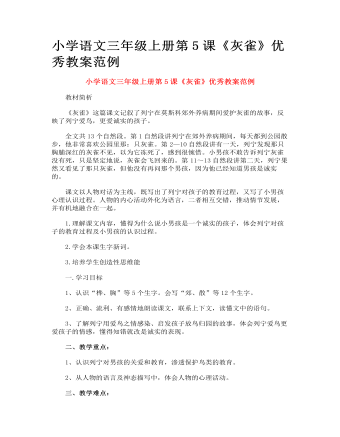
小学语文三年级上册第5课《灰雀》优秀教案范例
教材简析 《灰雀》这篇课文记叙了列宁在莫斯科郊外养病期间爱护灰雀的故事,反映了列宁爱鸟,更爱诚实的孩子。 全文共13个自然段。第1自然段讲列宁在郊外养病期间,每天都到公园散步,他非常喜欢公园里那:只灰雀。第2—10自然段讲有一天,列宁发现那只胸脯深红的灰雀不见,以为它冻死了,感到很惋惜。小男孩不敢告诉列宁灰雀没有死,只是坚定地说,灰雀会飞回来的。第11~13自然段讲第二天,列宁果然又看见了那只灰雀,但他没有再问那个男孩,因为他已经知道男孩是诚实的。 课文以人物对话为主线,既写出了列宁对孩子的教育过程,又写了小男孩心理认识过程。人物的内心活动外化为语言,二者相互交错,推动情节发展,并有机地融合在一起。
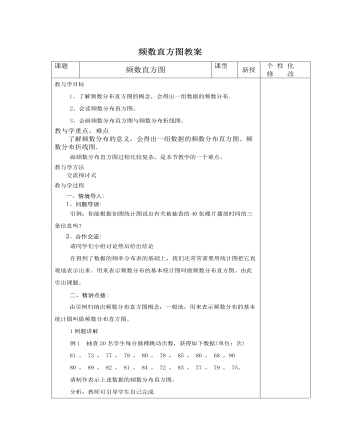
北师大初中七年级数学上册频数直方图教案2
[师]同学们想一想,你同父母一起去商店买衣服时,衣服上的号码都有哪些,标志是什么?[生]我看到有些衣服上标有M、S、L、XL、XXL等号码.但我不清楚代表的具体范围.适合什么人穿.但肯定与身高、胖瘦有关.[师]这位同学很善动脑,也爱观察. S代表最小号,身高在150~155 cm的人适合穿S号.M号适合身高在155~160 cm的人群着装…….厂家做衣服订尺寸也并不是按所有人的尺寸定做,而是按某个范围分组批量生产.如何确定组距与组数呢?分组组数的确定,不仅与数据多少有关,还与数据的取值情况有关.在实际决定组数时,常有一个尝试过程:先定组距,再计算出相应的组数.看看这个组数是否大致符合确定组数的经验法则.在尝试中,往往要比较相应于几个组距的组数,然后从中选定一个较为合适的组数.我们一起看下表:小亮的做法.
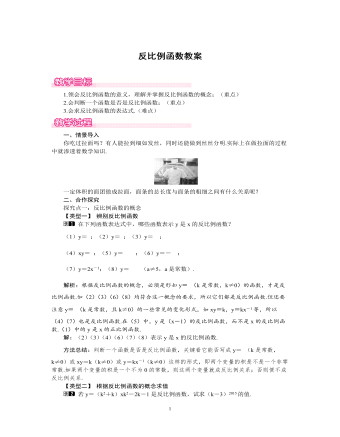
北师大初中数学九年级上册反比例函数1教案
解:(1)根据题意,可得y=100025x,化简得y=40x;(2)根据题设可知自变量x的取值范围为0<x<85.方法总结:反比例函数的自变量取值范围是全体非零实数,但在解决实际问题的过程中,自变量的取值范围要根据实际情况来确定.解题过程中应该注意对题意的正确理解.三、板书设计反比例函数概念:一般地,如果两个变量x,y之间 的对应关系可以表示成y=kx(k 为常数,k≠0)的形式,那么称y 是x的反比例函数,反比例函数 的自变量x不能为0确定表达式:待定系数法建立反比例函数的模型结合实例引导学生了解所讨论的函数的表达形式,形成反比例函数概念的具体形象,从感性认识到理性认识的转化过程,发展学生的思维.利用多媒体创设大量生活情境,让学生体验数学来源于生活实际,并为生活实际服务,让学生感受数学有用,从而培养学生学习数学的兴趣.
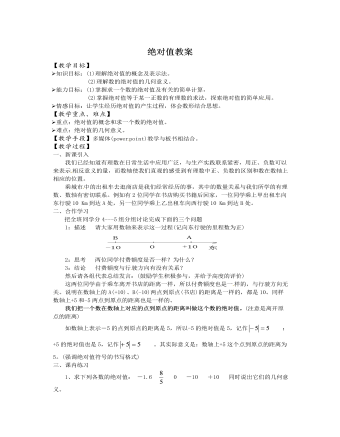
北师大初中七年级数学上册绝对值教案2
4、 填表:相反数 绝对值21 0 -0.75 5、 画一条数轴,在数轴上分别标出绝对值是6 , 1.2 , 0 的数6、 计算:(1) (2) 五、探究学习1、某人因工作需要租出租车从A站出发,先向南行驶6 Km至B处,后向北行驶10 Km至 C处,接着又向南行驶7 Km至D处,最后又向北行驶2 Km至E处。请通过列式计算回答下列两个问题:(1) 这个人乘车一共行驶了多少千米?(2) 这个人最后的目的地在离出发地的什么方向上,相隔多少千米 ?2、写出绝对值小于3的整数,并把它们记在数轴上。六、小结一头牛耕耘在一块田 地上,忙碌了一整天,表面上它在原地踏步,没有踏出这块土地,但我们说,它付出了艰辛和汗水,因为它所走过 的距离之和,有时候我们是无法 想象的。这就是今天所学的绝对值的意义所在。所以绝对值是不考虑方向意义时的一种数值表示。七、布置作业做作业本中相应的部分。

北师大初中七年级数学上册代数式教案2
1.进一步理解字母表示数的意义,能结合具体情景给字母赋于实际意义;理解代数式和代数式的值的意义,能解释一些简单代数式的实际背景或几何意义,在具体情景中能求出代数式的值. (重难点)2.通过创设实际背景和引用符号,经历观察、体验、验算、猜想、归纳等数学过程,体会数学与现实世界的联系,增强符号感,发展运用符号解决问题和数学探究意识. 教法学法:教学方法:引导—探究—发现法.学习方法:自主探究与合作交流相结合.课前准备:多媒体课件、投影仪、电脑教学过程:一、创设情境,引入新课.欣赏视频,导入新课师:国庆六十周年大阅兵,同学们看了吗?首先请同学们来欣赏一段视频.(26秒.定格在胡锦涛主席乘坐红旗轿车阅兵的一个瞬间.)师:这是新中国成立以来,规模最大、装备最新、机械化程度最高的一次大阅兵.
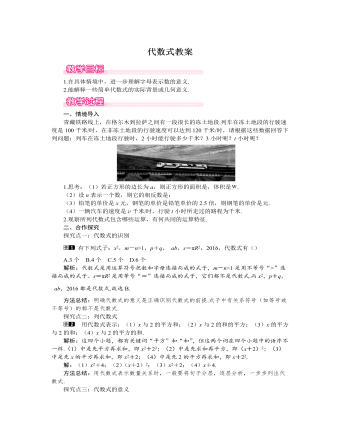
北师大初中七年级数学上册代数式教案1
方法总结:描述一个代数式的意义,可以从字母本身出发来描述字母之间的数量关系,也可以联系生活实际或几何背景赋予其中字母一定的实际意义加以描述.探究点四:根据实际问题列代数式用代数式表示下列各式:(1)王明同学买2本练习册花了n元,那么买m本练习册要花多少元?(2)正方体的棱长为a,那么它的表面积是多少?体积呢?解析:(1)根据买2本练习册花了n元,得出买1本练习册花n2元,再根据买了m本练习册,即可列出算式.(2)根据正方体的棱长为a和表面积公式、体积公式列出式子.解:(1)∵买2本练习册花了n元,∴买1本练习册花n2元,∴买m本练习册要花12mn元;(2)∵正方体的棱长为a,∴它的表面积是6a2;它的体积是a3.方法总结:此题考查了列代数式,用到的知识点包括正方体的表面积公式和体积公式,根据题意列出式子是解本题的关键.
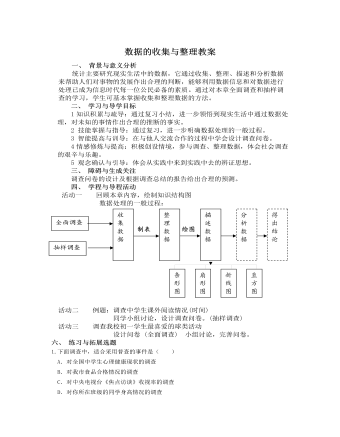
北师大初中七年级数学上册第六章复习教案
一、 背景与意义分析统计主要研究现实生活中的数据,它通过收集、整理、描述和分析数据来帮助人们对事物的发展作出合理的判断,能够利用数据信息和对数据进行处理已成为信息时代每一位公民必备的素质。通过对本章全面调查和抽样调查的学习,学生可基本掌握收集和整理数据的方法。二、 学习与导学目标1 知识积累与疏导:通过复习小结,进一步领悟到现实生活中通过数据处理,对未知的事情作出合理的推断的事实。2 技能掌握与指导:通过复习,进一步明确数据处理的一般过程。3 智能提高与训导:在与他人交流合作的过程中学会设计调查问卷。4 情感修炼与提高:积极创设情境,参与调查、整理数据,体会社会调查的艰辛与乐趣。5 观念确认与引导:体会从实践中来到实践中去的辨证思想。三、 障碍与生成关注调查问卷的设计及根据调查总结的报告给出合理的预测。四、 学程与导程活动活动一 回顾本章内容,绘制知识结构图

北师大初中七年级数学上册第三章复习教案
一.学习目的和要求:1.对本章内容的认识更全面、更系统化。2.进一步加深对本章基础知识的理解以及基本技能的掌握,并能灵活运用。二.学习重点和难点:重点:本章基础知识的归纳、总结;基础知识的运用;整式的加减运算的灵活运用。难点:本章基础知识的归纳、总结;基础知识的运用;整式的加减运算的灵活运用与提高。三.学习方法:归纳,总结 交流、练习 探究 相结合 四.教学目标和教学目标解析:教学目标1 同类项 同类项:所含字母相同,并且相同字母的指数也分别相等的项,另外所有的常数项都是同类项。例如: 与 是同类项; 与 是同类项。注意:同类项与系数大小无关,与字母的排列顺序无关。教学目标2 合并同类项法则 合并同类项法则:把同类项的系数相加,所得结果作为系数,字母和字母的指数保持不变,如: 。
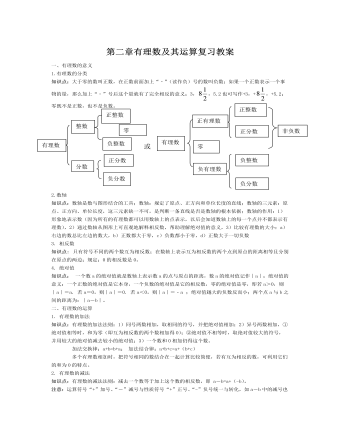
北师大初中七年级数学上册第二章复习教案
. 一个数的倒数等于它本身的数是()A.1 B. C.±1 D.04. 下列判断错误的是()A.任何数的绝对值一定是非负数; B.一个负数的绝对值一定是正数;C.一个正数的绝对值一定是正数; D.一个数不是正数就是负数;5. 有理数a、b、c在数轴上的位置如图所示则下列结论正确的是()A.a>b>0>c B.b>0>a>cC.b<a<0< D.a<b<c<06.两个有理数的和是正数,积是负数,则这两个有理数( )A.都是正数; B.都是负数; C.一正一负,且正数的绝对值较大; D.一正一负,且负数的绝对值较大。7.若│a│=8,│b│=5,且a + b>0,那么a-b的值是( )A.3或13 B.13或-13 C.3或-3 D.-3或-138. 大于-1999而小于2000的所有整数的和是()A.-1999 B.-1998 C.1999 D.20009. 当n为正整数时, 的值是()
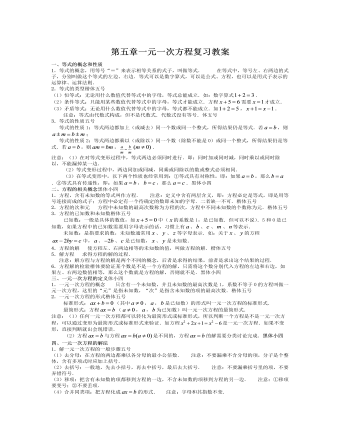
北师大初中七年级数学上册第五章复习教案
16.已知甲组有28人,乙组有20人,则下列调配方法中,能使一组人数为另一组人数的一半的是( ).A.从甲组调12人去乙组 B.从乙组调4人去甲组C.从乙组调12人去甲组 D.从甲组调12人去乙组,或从乙组调4人去甲组17.足球比赛的规则为胜一场得3分,平一场得1分,负一场是0分,一个队打了14场比赛,负了5场,共得19分,那么这个队胜了( )场.A.3 B.4 C.5 D.618.如图所示,在甲图中的左盘上将2个物品取下一个,则在乙图中右盘上取下几个砝码才能使天平仍然平衡?( )A.3个 B.4个 C.5个 D.6个三、解答题.(19,20题每题6分,21,22题每题7分,23,24题每题10分,共46分)19.解方程:2(x-3)+3(2x-1)=5(x+3)20.解方程: 21.如图所示,在一块展示牌上整齐地贴着许多资料卡片,这些卡片的大小相同,卡片之间露出了三块正方形的空白,在图中用斜线标明.已知卡片的短边长度为10厘米,想要配三张图片来填补空白,需要配多大尺寸的图片.
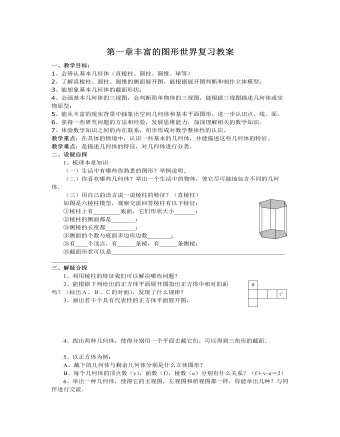
北师大初中七年级数学上册第一章复习教案
一、教学目标:1、会辨认基本几何体(直棱柱、圆柱、圆锥、球等)2、了解直棱柱、圆柱、圆锥的侧面展开图,能根据展开图判断和制作立体模型;3、能想象基本几何体的截面形状;4、会画基本几何体的三视图,会判断简单物体的三视图,能根据三视图描述几何体或实物原型;5、能从丰富的现实背景中抽象出空间几何体和基本平面图形,进一步认识点、线、面。6、获得一些研究问题的方法和经验,发展思维能力,加深理解相关的数学知识。7、体验数学知识之间的内在联系,初步形成对数学整体性的认识。教学重点:在具体的情境中,认识一些基本的几何体,并能描述这些几何体的特征。教学难点:是描述几何体的特征,对几何体进行分类。二、设疑自探1、梳理本章知识(一)生活中有哪些你熟悉的图形?举例说明.(二)你喜欢哪些几何体?举出一个生活中的物体,使它尽可能地包含不同的几何体.(三)用自己的语言说一说棱柱的特征?(直棱柱)
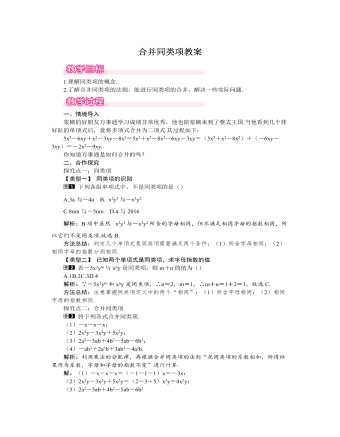
北师大初中七年级数学上册合并同类项教案1
一天,王村的小明奶奶提着一篮子土豆去换苹果,双方商定的结果是:1千克土豆换0.5千克苹果.当称完带篮子的土豆重量后,摊主对小明奶奶说:“别称篮子的重量了,称苹果时也带篮子称,这样既省事又互不吃亏.”你认为摊主的话有道理吗?请你用所学的有关数学知识加以判定.解析:要看摊主说得有没有道理,只要按称篮子和不称篮子两种方式分别求出所得苹果的重量,比较即可.解:设土豆重a千克,篮子重b千克,则应换苹果0.5a千克.若不称篮子,则实换苹果为0.5a+0.5b-b=(0.5a-0.5b)千克,很明显小明奶奶少得苹果0.5b千克.所以摊主说得没有道理,这样做小明奶奶吃亏了.方法总结:体现了数学在生活中的运用.解决问题的关键是读懂题意,找到所求的量之间的关系.三、板书设计数学教学要紧密联系学生的生活实际,本节课从实际问题入手,引出合并同类项的概念.通过独立思考、讨论交流等方式归纳出合并同类项的法则,通过例题教学、练习等方式巩固相关知识.教学中应激发学生主动参与学习的积极性,培养学生思维的灵活性.